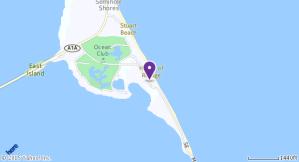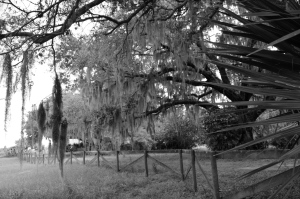Yesterday, I drove over to Sarasota to see my family and go to a party. It was a pretty special day. Two birthdays and we would find out a baby gender. I decided to take Barney because there would be a fenced in back yard and it’s cool enough if you leave early in the morning for him to be in the car.
Even though there is so much to talk about, think about and write about we have to remember why we are here in the first place.
It’s a great ride.
We started off in Jensen Beach from our little house on the hill and this glorious sunrise.

Here is Barney my almost 18 year old golden. There’s nothing he loves more than a “Woad Twip.”

Here’s the fog out at fog at Alapattah Flats Management Area. I’m still in Martin County.

Here is our Martin Grade Scenic Hwy. It’s fabulous and worth the ride. The best ride would be coming from the west early in the morning because the light is amazing. Make sure you have a driver because there is no place to stop. I looked behind me as I drove and it was like the light was following me down the road.

The end of this road is the end of Martin County.
Through Okeechobee, Highland County and onto Desoto County which has a grand sign about tranquility and prosperity and something else I can’t remember.
I had to stop. The main reason was I really needed a bathroom and it’s very hard when you travel alone with a dog to find a place you can just run into and safely leave your dog in the car with the windows down. Barney barks not when you come towards him but when you leave. I’m sure if we were ever robbed he would bark as the robber’s were leaving abandoning him. “Come back. Don’t leave me!”
Just an interesting note. In Arcadia, FL the streets are names for the Florida Counties. I’ve stopped there a few times and I really need to go back and I think it would a fun place to meet the kids in the future.
Check it out.
“Arcadia is famous throughout Florida for its historic downtown antique district. Additionally, on the fourth Saturday of each month, vendors from surrounding locations take over our streets with even more wares and precious finds. Tucked between the shops, you’ll have the chance to enjoy cafés, home cooking, a tea room and even an old fashion ice cream parlor, complete with homemade delicious flavors, sundaes and shakes.”
The second reason was I wized past this place so many times I just wanted to see what it was and take Barney for a little walk and shoot some photos.
Across the road there were guns going off. Hundreds of cars and people shooting guns and a big no trespassing sign.
This is where we went.
http://www.desotobocc.com/department/parks_recreation/desoto-veterans-memorial-park
DeSoto Veterans Memorial Park
2195 NW American Legion Dr Arcadia, FL 34266
“With boat ramp and picnic areas, this park is used frequently by groups and large gatherings such as Pioneer Days and Relay for Life. With the shade provided by the large oak trees, this is the perfect place to park and enjoy your lunch hour. This park also features restroom facilities.”
When traveling in Florida you always to leave a little early because there’s always someplace to stop with your dog and take a moment to breath and use the rest room.
Here is the Peace RIver.
https://en.wikipedia.org/wiki/Peace_River_%28Florida%29
From Wikipedia, the free encyclopedia (photos are mine)
The Peace River is a river in the southwestern part of the Florida peninsula, in the U.S.A. It originates at the juncture of Saddle Creek and Peace Creek northeast of Bartow in Polk County and flows south through Hardee County to Arcadia in DeSoto County

and then southwest into the Charlotte Harbor estuary at Port Charlotte in Charlotte County. It is 106 miles (171 km) long and has a drainage basin of 1,367 square miles (3,540 km2). U.S. Highway 17 runs near and somewhat parallel to the river for much of its course. The river was called Rio de la Paz (River of Peace) on 16th century Spanish charts. It appeared as Peas Creek or Pease Creek on later maps. The Creek (and later, Seminole) Indians call it Talakchopcohatchee, River of Long Peas.[3] Other cities along the Peace River include Fort Meade, Wauchula and Zolfo Springs.

Fresh water from the Peace River is vital to maintain the delicate salinity of Charlotte Harbor that hosts several endangered species, as well as commercial and recreational harvests of shrimp, crabs, and fish. The river has always been a vital resource to the people in its watershed. Historically, the abundant fishery and wildlife of Charlotte Harbor supported large populations of people of the Caloosahatchee culture (in early historic times, the Calusa). Today, the Peace River supplies over six million gallons per day of drinking water to the people in the region. The river is also popular for canoeing.[5]
There were many Pleistocene and Miocene fossils found throughout the Peace River area, eventually leading to the discovery of phosphate deposits. Most of the northern watershed of the Peace River comprises an area known as the Bone Valley.
The Peace River is a popular destination for fossil hunters who dig and sift the river gravel for fossilized shark teeth and prehistoric mammal bones. Several campgrounds and canoe rental operations cater to fossil hunters, with Wauchula, Zolfo Springs, and Arcadia being the main points of entry.
http://www.protectingourwater.org/watersheds/map/sarasota_bay_peace_myakka/peace/
A number of major restoration activities are under way in the watershed, particularly in the Peace River region. The objectives of the SWFWMD’s Upper Peace River Watershed Restoration Initiative include the restoration of surface water storage and flows and aquifer recharge, as well as improvement to water quality and ecosystems that have been lost, degraded, or significantly altered. The initiative will provide a critical link to a major greenway that extends from Florida’s lower west coast up through the Peace River watershed and Green Swamp, and north to the Ocala National Forest. Projects undertaken through the initiative involve Lake Hancock, the upper Peace River, and the Peace Creek Canal.
Why can’t I just write a blog about the great things in Florida.

THREAT: PHOSPHATE MINING
HUGE PHOSPHATE MINES ARE DEVOURING THE PEACE RIVER WATERSHED, LEAVING BEHIND UNSTABLE CLAY POOLS THAT PREVENT WATER FROM REACHING THE RIVER — UNTIL THEY COLLAPSE.
Peace River Makes the 2004 Most Endangered Rivers List
Lorelei Jackson
04.14.04
Florida – America’s rivers and streams are becoming more polluted — and the White House and Congress are making a bad situation worse by cutting clean water law enforcement and spending on pollution prevention, charged American Rivers with the release of its 2004 Most Endangered Rivers report.
* On President Bush’s watch, EPA is issuing less than half as many “violation notices” to polluters who break the law, and is levying smaller fines, as well
* One-fourth of America’s largest industrial and sewage treatment plants are in “significant noncompliance” with water pollution standards at any one time
* The White House and Congress have declined to reauthorize the Superfund tax to ensure that polluters pay to cleanup toxic waste instead of the taxpayers
* On his first day in office, President Bush scrapped a proposal to require wastewater treatment plants to notify the public when the spill sewage into streams and rivers.
* In November 2003, the EPA proposed to sanction dumping fully and partially treated sewage into rivers when it rains.
* The federal government used to pay 20% of water infrastructure costs. Now it pays 5% and President Bush has asked the Congress to cut this by another third for 2005.
* Removed restrictions that protect streams from mountaintop removal coal mining
* Issued new nationwide permits for building shopping centers, tract housing, and corporate campuses on top of wetlands and flood-prone areas
* Discouraged federal field staff from protecting many wetlands and streams under the Clean Water Act.
* 51% of the mouths of America’s rivers were designated “impaired” in 2000, up from 37% in 1994
* EPA estimates that sanitary sewers overflow directly into streams, lakes, and estuaries 40,000 times and that as many as 3.5 million American get sick from swimming in water laced with sewage each year.
* Forty-three states have issued fish-consumption advisories along 500,000 miles of river
* The United States loses 60,000 acres of wetlands each year – increasing the frequency and severity of floods
Summary
Phosphate mining in the Peace River watershed has been the source of serious environmental problems for many years, and large new mines are planned. Florida’s Department of Environmental Protection (DEP) and the Southwest Florida Water Management District (SWFWMD) must take measures to safeguard the river and communities in the watershed from mining impacts, including protecting drinking water, and important tourism and commercial fishing industries.
I have to do more research. If any of you guys have any more info email me at clenz@mac.com.














































Joe Vogel on April 4, 2015 at 4:40 amThe original Prince Theatre was replaced in 1940. The April 5, 1940, issue of The Film Daily had this item:
This follow-up item is from the January 3, 1941, issue of The Film Daily:
Listings of the Prince Theatre in FDY’s from the 1930s consistently give it a capacity of 250, so it was less than half the size of the new house. It seems unlikely that the original Prince Theatre would have been demolished in 1940 if its building was only nine years old, so it’s likely that it was either an older theater that had operated under a different name earlier in its history, or it was in an older commercial building that had been converted into a theater in 1931.Architect Chester A. Cone was still in practice at least as late as 1985, so it seems likely that it was the 1940 rebuilding of the Prince Theatre that he designed, rather than the original house.
In 1966, the Gold-Dobrow chain leased three of their five theaters, including the Prince, to a Miami-based chain. An article about the transfer in the December 21 issue of The Palm Beach Post said that the Gold-Dobrow chain had been “…organized about 35 years ago….” That would be consistent with the 1931 opening of the original Prince Theatre, whether it was a new operation or an old house renamed by the new owners.